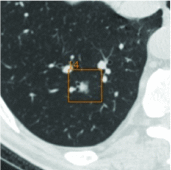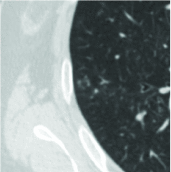[Performance of Deep-learning-based Artificial Intelligence on Detection of Pulmonary Nodules in Chest CT]
- PMID: 31196366
- PMCID: PMC6580084
- DOI: 10.3779/j.issn.1009-3419.2019.06.02
[Performance of Deep-learning-based Artificial Intelligence on Detection of Pulmonary Nodules in Chest CT]
Abstract
Background: The detection of pulmonary nodules is a key step to achieving the early diagnosis and therapy of lung cancer. Deep learning based Artificial intelligence (AI) presents as the state of the art in the area of nodule detection, however, a validation with clinical data is necessary for further application. Therefore, the aim of this study is to evaluate the performance of AI in the detection of malignant and non-calcified nodules in chest CT.
Methods: Two hundred chest computed tomography (CT) data were randomly selected from a self-built nodule database from Tianjin Medical University General Hospital. Both the pathology confirmed lung cancers and the nodules in the process of follow-up were included. All CTs were processed by AI and the results were compared with that of radiologists retrieved from the original medical reports. The ground truths were further determined by two experienced radiologists. The size and characteristics of the nodules were evaluated as well. The sensitivity and false positive rate were used to evaluate the effectiveness of AI and radiologists in detecting nodules. The McNemar test was used to determine whether there was a significant difference.
Results: A total of 889 non-calcified nodules were determined by experts on chest CT, including 133 lung cancers. Of them, 442 nodules were less than 5 mm. The cancer detection rates of AI and radiologists are 100%. The sensitivity of AI on nodule detection was significantly higher than that of radiologists (99.1% vs 43%, P<0.001). The false-positive rate of AI was 4.9 per CT and decreased to 1.5 when nodules less than 5 mm were excluded.
Conclusions: AI achieves the detection of all malignancies and improve the sensitivity of pulmonary nodules detection beyond radiologists, with a low false positive rate after excluding small nodules.
【中文题目:基于深度学习的人工智能胸部CT肺结节检测效能评估】 【中文摘要:背景与目的 肺结节精确检测是实现肺癌早诊的基础。基于深度学习的人工智能在肺内结节检测领域发展迅速,对其效能进行验证是促进其应用于临床的前提。本研究旨在评估基于深度学习技术的人工智能软件在胸部计算机断层扫描(computed tomography, CT)恶性及非钙化结节检出中的价值。方法 由天津医科大学总医院自建胸部CT肺结节数据库中随机抽取200例胸部CT数据,包含病理证实的肺癌及随访结节病例,导入肺结节人工智能识别系统,记录软件自动识别结节,并与原始影像报告结果进行对比。人工智能软件及阅片者检测到的结节由2名胸部专家进行评估并记录其大小及特征。计算灵敏度、假阳性率评估人工智能软件及医师的结节检测效能,应用McNemar检验确定二者之间是否存在显著性差异。结果 200例胸部多层螺旋CT共包含非钙化结节889枚,其中肺癌结节133枚,小于5 mm结节442枚。人工智能及放射科医师肺癌检出率皆为100%。人工智能软件结节检测灵敏度明显高于放射科医师(99.1% vs 43%, P<0.001)。人工智能总体假阳性率为每例CT 4.9个,排除5 mm以下结节后降为1.5个。结论 基于深度学习的人工智能软件能实现恶性肺结节的无漏诊检出,具有较医师更高的结节检出灵敏度,在排除微小结节后可降低假阳性率。 】 【中文关键词:计算机体层成像;肺结节;深度学习;人工智能;检出】.
Keywords: Artificial intelligence; Computed tomography; Deep learning; Detection; Lung nodules.
Figures



Similar articles
-
Validation of a Deep Learning Algorithm for the Detection of Malignant Pulmonary Nodules in Chest Radiographs.JAMA Netw Open. 2020 Sep 1;3(9):e2017135. doi: 10.1001/jamanetworkopen.2020.17135. JAMA Netw Open. 2020. PMID: 32970157 Free PMC article.
-
An AI deep learning algorithm for detecting pulmonary nodules on ultra-low-dose CT in an emergency setting: a reader study.Eur Radiol Exp. 2024 Nov 20;8(1):132. doi: 10.1186/s41747-024-00518-1. Eur Radiol Exp. 2024. PMID: 39565453 Free PMC article.
-
Enhancing Diagnostic Accuracy of Lung Nodules in Chest Computed Tomography Using Artificial Intelligence: Retrospective Analysis.J Med Internet Res. 2025 Jan 27;27:e64649. doi: 10.2196/64649. J Med Internet Res. 2025. PMID: 39869890 Free PMC article.
-
Artificial intelligence and radiomics in pulmonary nodule management: current status and future applications.Clin Radiol. 2020 Jan;75(1):13-19. doi: 10.1016/j.crad.2019.04.017. Epub 2019 Jun 12. Clin Radiol. 2020. PMID: 31202567 Review.
-
[Artificial intelligence research advances in discrimination and diagnosis of pulmonary ground-glass nodules].Zhonghua Jie He He Hu Xi Za Zhi. 2024 Jun 12;47(6):566-570. doi: 10.3760/cma.j.cn112147-20231214-00370. Zhonghua Jie He He Hu Xi Za Zhi. 2024. PMID: 38858209 Review. Chinese.
Cited by
-
Performance of Deep-Learning Solutions on Lung Nodule Malignancy Classification: A Systematic Review.Life (Basel). 2023 Sep 14;13(9):1911. doi: 10.3390/life13091911. Life (Basel). 2023. PMID: 37763314 Free PMC article. Review.
-
Cuproptosis-related gene identification and immune infiltration analysis in systemic lupus erythematosus.Front Immunol. 2023 May 29;14:1157196. doi: 10.3389/fimmu.2023.1157196. eCollection 2023. Front Immunol. 2023. PMID: 37313407 Free PMC article.
-
Pulmonary Nodule Clinical Trial Data Collection and Intelligent Differential Diagnosis for Medical Internet of Things.Contrast Media Mol Imaging. 2022 May 26;2022:2058284. doi: 10.1155/2022/2058284. eCollection 2022. Contrast Media Mol Imaging. 2022. PMID: 35685674 Free PMC article.
-
Artificial intelligence-based graded training of pulmonary nodules for junior radiology residents and medical imaging students.BMC Med Educ. 2024 Jul 9;24(1):740. doi: 10.1186/s12909-024-05723-5. BMC Med Educ. 2024. PMID: 38982410 Free PMC article.
-
Progress of Artificial Intelligence in Gynecological Malignant Tumors.Cancer Manag Res. 2020 Dec 14;12:12823-12840. doi: 10.2147/CMAR.S279990. eCollection 2020. Cancer Manag Res. 2020. PMID: 33364831 Free PMC article. Review.
References
-
- Tsutani Y, Miyata Y, Nakayama H, et al. Prognostic significance of using solid versus whole tumor size on high-resolution computed tomography for predicting pathologic malignant grade of tumors in clinical stage IA lung adenocarcinoma: a multicenter study. J Thorac Cardiovasc Surg. 2012;143(3):607–612. doi: 10.1016/j.jtcvs.2011.10.037. - DOI - PubMed
MeSH terms
LinkOut - more resources
Full Text Sources
Medical
Research Materials

